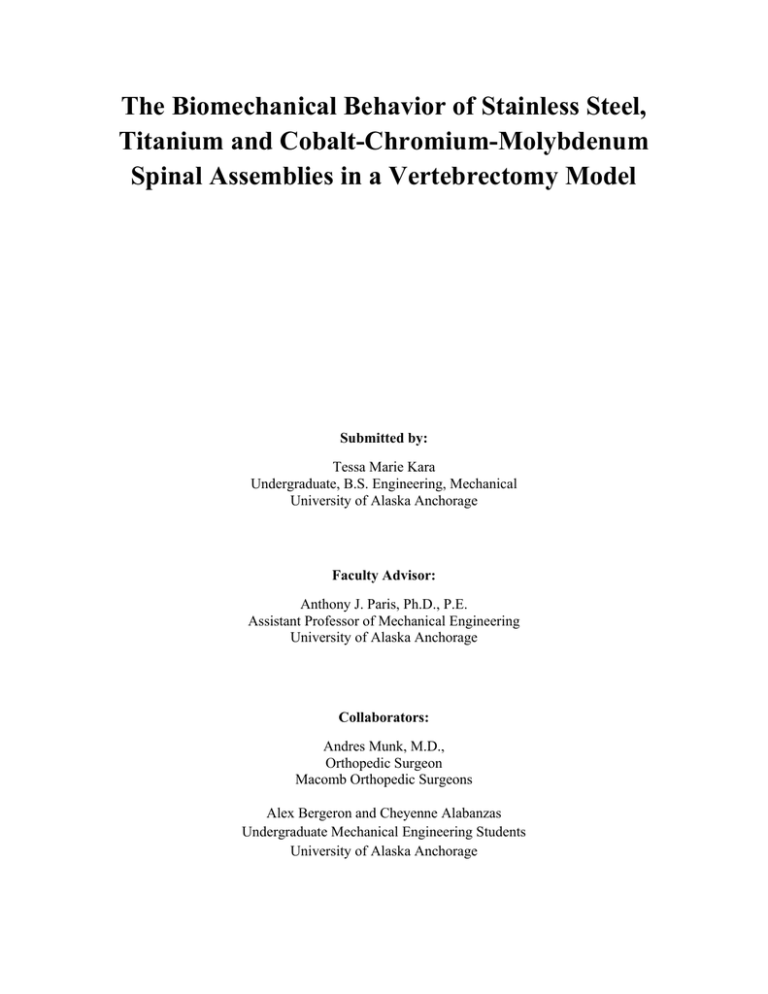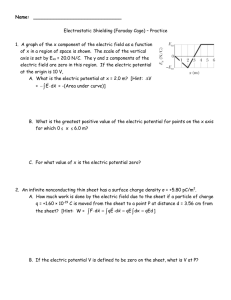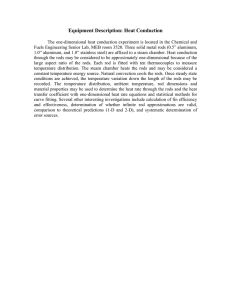The Biomechanical Behavior of Stainless Steel, Titanium and Cobalt
advertisement

The Biomechanical Behavior of Stainless Steel, Titanium and Cobalt-Chromium-Molybdenum Spinal Assemblies in a Vertebrectomy Model Submitted by: Tessa Marie Kara Undergraduate, B.S. Engineering, Mechanical University of Alaska Anchorage Faculty Advisor: Anthony J. Paris, Ph.D., P.E. Assistant Professor of Mechanical Engineering University of Alaska Anchorage Collaborators: Andres Munk, M.D., Orthopedic Surgeon Macomb Orthopedic Surgeons Alex Bergeron and Cheyenne Alabanzas Undergraduate Mechanical Engineering Students University of Alaska Anchorage Abstract: The objective of this study is to provide a qualitative and quantitative comparison of the biomechanical behavior of stainless steel, titanium and cobalt–chromium–molybdenum alloy spinal fixation assemblies. Displacement controlled static compression tests will be performed in vitro. Resulting data will be analyzed and published for review. Spinal rods are used to treat instability or deformation of the spine in medical patients. They are used as a treatment to scoliosis, fractures, disc disease or other spinal trauma. The purpose of the spinal rod is twofold; to reduce or stop unwanted curvature in the spinal column and to provide stability to the spinal column, thus enabling the targeted vertebrae to fuse. (Foundation) Fusion and successful completion of solid bone mass may take up to a year. During this time the spinal rod must withstand daily destructive forces, including impact vibrations and bending moments. The rod will eventually fail if solid fusion in the vertebrae is not achieved. Little is known about the relative biomechanical properties of SS to Ti to Co-Cr-Mo. This study will compare load vs. displacement analysis for SS, Ti and Co-Cr-Mo when used as internal supports for the spinal column. The constructs, or rods, will be subjected to displacement controlled static compression tests. The displacements and loads will be recorded and compared. The rods will be fixed to a Lumbar UHMWPE Block using pedicle screws. The assemblies will be applied using the methods and tools used by surgeons. The stiffness, yield load, and maximum load for each alloy will be compared. Figure 1. Modified Galveston Technique for spinopelvic reconstruction. (MedScape, 1994) The study will test SS, Ti, and Co-Cr-Mo spinal fixation assemblies to determine if the biomechanical behaviors of the constructs are different. This comparison may aid professionals and patients in making informed choices when designing, implementing and living with spinal rods. To guide in the clinical perspective, orthopedic surgeon Dr. Andres Munk, M.D., Macomb Orthopedic Surgeons, will serve as a collaborating researcher. Introduction: Spinal rods must immobilize and straighten the spine from the inside until complete vertebrae fusion has occurred. During this time, which may take up to a year, the assembly must withstand various detrimental forces. Men take an average of 7192 steps per day and women 5210 steps per day. (About.Com, 2009) Each step a person takes corresponds to a loading cycle felt by the spinal rod. Over time, the loading may lead to rod fractures. In addition to cyclical loading, spinal rods are subjected to bending of the spine, lifting objects and other activities initiated by the patient. This study will analyze the mechanical properties of SS, Ti and Co-Cr-Mo spinal fixation assemblies under simulated forces designed to mimic the stresses listed above. This is important because the mechanical properties are directly related to the rods success during and after surgery. The biomechanical behavior of lumbar spinal fixation constructs with SS, Ti and Co-Cr-Mo screws and rods will be determined and compared. Orthopedic surgeons using SS and Ti rods have reported different cutting and bending behaviors. (Paris, Final Report A study on the Biomechanical Behavior of Spinal-Pelvic Fixation Assemblies with Stainless Steel and Titanium Rods in a Vertebrectomy Model Phase II: The Effect of Lordosis, 2005) It is believed that the same will be true for Co-Cr-Mo rods when compared to SS and Ti. While the SS and Ti alloys have been around for many years, the relatively new Co-Cr-Mo alloys may have superior mechanical properties. The proposed study will provide both a quantitative and qualitative comparison of the static biomechanical behavior of the SS, Ti and Co-Cr-Mo assemblies. Figure 2. MTS universal testing machine (UAA, SOE) Sample rods will be tested for stiffness, yield load, and maximum load between the three metals. The MTS Universal Test Machine, shown in Figure 2, is available at the UAA School of Engineering and will be used for these tests. The data collected will be used to determine displacement and load values for each metal alloy. These results are required to conduct further research, such as fatigue studies of spinal fixation assemblies, and will be submitted for publication to the journal of Spine and for presentation at the ASME Summer Bioengineering Conference or similar. Experiment/Project Design: Figure 3: Lumbar block with assembly The mechanical tests will be performed using the MTS Universal Test Machine, shown in Figure 2. Two rods will be secured to simulated lumbar vertebra using pedicle screws following ASTM F1717 Standard Test Methods for Spinal Implant Constructs in a Vertebrectomy Model. The geometry of the lumbar block is consistent with the guidelines provided in ASTM 1717-96. The constructs simulate a vertebrectomy by providing a large gap between the two lumbar blocks. The simulated lumbar vertebras are constructed from an Ultra High Molecular Weight Polyethylene block. The lumbar block is already constructed and meets ASTM guidelines. The SS, Ti and Co-Cr-Mo rods and screws will be provided by Johnston & Johnston DePuy Spine. The rods will be cut and the assemblies will be applied to the UHMWPE vertebra using the methods and tools commonly used in surgery. The constructs will be placed in the MTS Universal Test Machine fitted with two clevis fixtures and subjected to displacement controlled static compression tests. Both displacement and load will be recorded. If fracture or slipping within the construct or gross asymmetric deformation of the rods does not occur, the test will be ended when interference is impending. If fracture or slipping within the construct or gross asymmetric deformation does occur, the test will be ended, the construct will be photographed, and the mode of the failure will be noted. A statistical analysis will compare the stiffness, yield load, and maximum load between the three metals. Constructs will be photographed before and after each test and disassembled following the tests. The data will be represented in a load vs. displacement plot for SS, Ti and Co-Cr-Mo. An example plot is shown below. (Paris, The Biomechanical Behavior of Spinal-Pelvic Fixation Assemblies with Stainless Steel and Titanium Rods in a Vertebrectomy Model, 2005) The biomedical behavior, both the qualitative and quantitative results of the tests, of the constructs with SS, Ti, and Co-Cr-Mo assemblies will be compared against each other. In addition to submitting a report, the results of this study will be submitted for possible journal and conference publication. Figure 4: Representative load vs. displacement plot. Anticipated Results: A load-displacement curve will be shown for all the static compression tests. The mean and standard deviation for the static compressive displacement at 2% offset yield (mm), elastic displacement (mm), yield load (N), stiffness (N/mm), ultimate displacement (mm), and ultimate load (N) will be reported. Displacement vs. load curves from prior studies comparing SS and Ti constructs were bilinear with a smooth transition between the steep linear elastic portion of the curve and the nearly linear stain-hardening portion of the curve. It is expected that the SS, Ti and Co-R-Mo alloys will show similar load-deformation curve characteristics. The biomechanical behavior, both the qualitative and quantitative results of the tests, of the constructs with SS, Ti and Co-Cr-Mo will be compared. The results from this study are required for further research, such as fatigue studies of spinal fixation constructs. Project Budget: Table1: Proposed Budget Items Quantity Cost/Unit ($) Total Cost ($) SS Rods 1 160 160 Titanium Rods 1 190 190 Cobalt Chrome Rods 1 880 880 Pedicle screws of Cobalt Chrome 2 655 1,310 Matching SOE Funds <540> Total 2,000 Budget Justification: The proposed budget for this project is given in Table 1. The total budget requested funding $2000. One rod for each material will be necessary to complete two tests for each material totaling to $1230. Two pedicle screws of Co-Cr-Mo total to $1310. Pedicle screws for the titanium and stainless steel are already available. The UHMW PE blocks and steel fixtures that are required for the test are already available. Matching funds of $540 have been made available by the SOE. Project Timeline: Table 2: Project Timeline Task Name Duration Start Finish Resource Acquire Rods 4 wks 01/5/2009 01/26/2009 Johnston & Johnston DePuy, Inc. Machine constructs 1 wks 01/26/2009 02/02/2009 UAA SOE MTS Universal Testing SS 0.5 wks 02/02/09 02/05/09 UAA SOE MTS Universal Testing Titanium 0.5 wks 02/05/09 02/10/09 UAA SOE MTS Universal Testing Co-Chrome 0.5 wks 02/10/09 02/14/09 UAA SOE Data Analysis 5 wks 02/16/09 03/16/09 Faculty Advisor, Orthopedic Surgeon Write Report 3 wks 03/16/09 04/7/09 Faculty Advisor, Orthopedic Surgeon Present Findings 1 day 04/17/09 04/17/09 UAA References: About.Com. (2009, 5 8). Retrieved 10 17, 2009, from About.Com:Walking: htp://walking.about.com/od/measure/a/averagesteps.htm F1717‐96 Standard Test Methods for Spinal Implant Constructs in a Vertebrectomy Model, Annual Book of ASTM Standards, American Society for Testing and Materials, Vol. 13.01, 2002. F1798‐97 Standard Guide for Evaluating the Static and Fatigue Properties of Interconnection Mechanisms and Subassemblies Used in Spinal Arthrodesis Implants, Annual Book of ASTM Standards, American Society for Testing and Materials, Vol. 13.01, 2002. Foundation, N. S. (n.d.). The Purpose of Spinal Instruments. Retrieved 10 18, 2009, from National Scoliosis Foundaton: http://www.scoliosis.org/resources/medicalupdates/instrumentationsystems.php MedScape. (1994). Retrieved 10 17, 2009, from MedScape Today: http://www.medscape.com/viewarticle/461096_6 Paris, A. J. (2004). A Study on the Biomechanical Behavior of Spinal‐Pelvic Fixation Assemblies with Stainless Steel and Titanium Rods in a Vertebrectomy Model. Boise: Boise State University. Paris, A. J. (2005). Final Report A study on the Biomechanical Behavior of Spinal‐Pelvic Fixation Assemblies with Stainless Steel and Titanium Rods in a Vertebrectomy Model Phase II: The Effect of Lordosis. Boise: University of Boise. Paris, A. J. (2005). The Biomechanical Behavior of Spinal‐Pelvic Fixation Assemblies with Stainless Steel and Titanium Rods in a Vertebrectomy Model. Boise: Department of Mechanical Engineering, Boise State Univeristy. Works, H. S. (n.d.). How Stuff Works. Retrieved 10 17, 2009, from static.howstuffworks.com/gif/adam/images/en/1...: http://healthguide.howstuffworks.com/spinal‐ fusion‐series‐picture.htm


